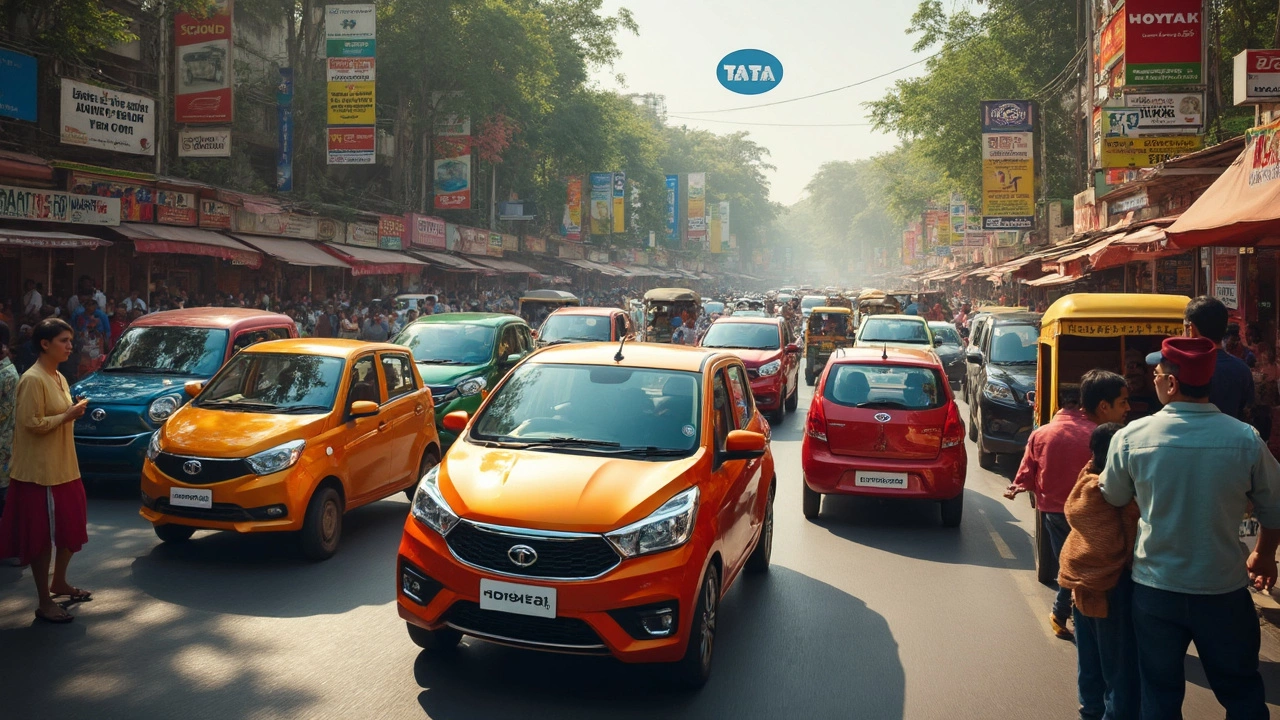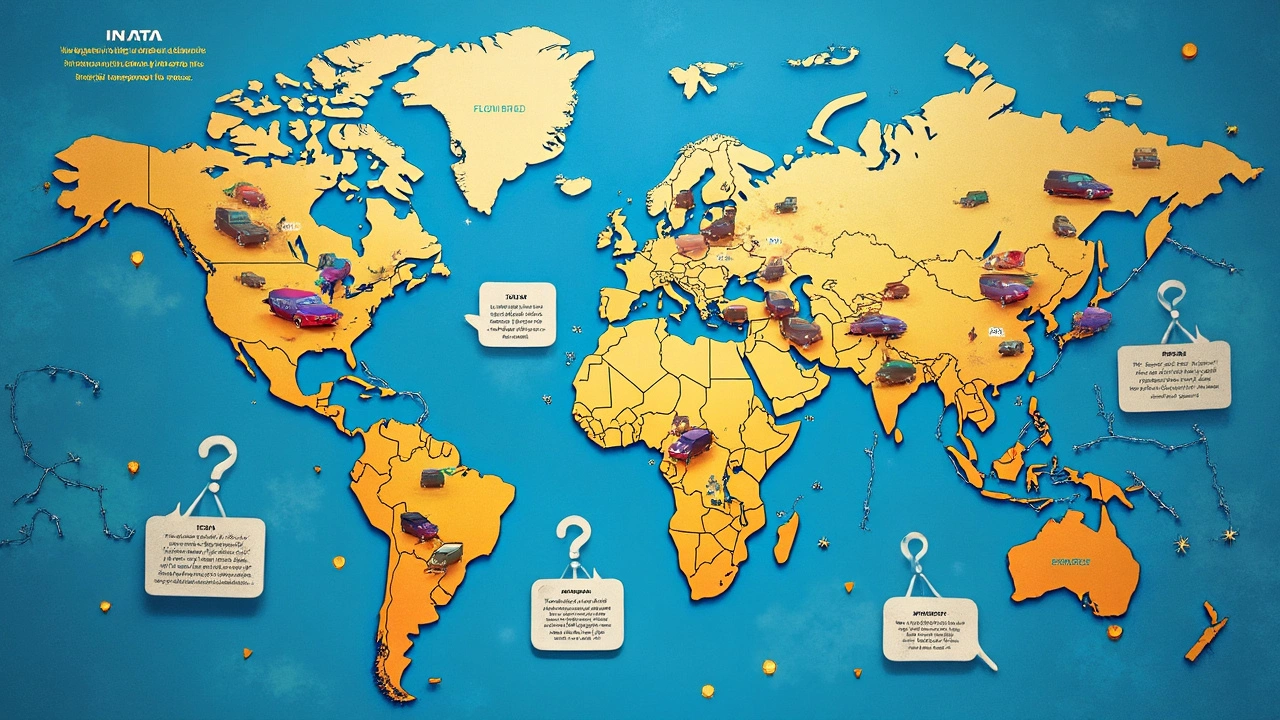 May, 31 2025
May, 31 2025
Ever noticed you never see a Tata car on the road in America? It's not just you. Tata Motors, a heavyweight in India’s auto scene, doesn’t actually sell its cars in the USA. People hear the name ‘Tata’ and sometimes mistake it for a luxury brand because of its ownership of Jaguar and Land Rover, but Tata-branded vehicles themselves are missing from the American market.
Here’s the deal: Tata is massive in India, with everything from tiny city cars like the Nano (which was once the world’s cheapest car) to big trucks and SUVs. But if you walk onto any US dealership, you won’t find a single Tata asset parked there—no hatchbacks, no SUVs, nothing. That probably feels weird considering the size of their global business, but there are good reasons why they aren’t here, and it’s not just because of taste or marketing. It comes down to things like strict safety rules, tough emissions standards, and the expensive process of getting cars certified for American roads.
- What is Tata Motors?
- Why Tata Cars Aren't in the USA
- Tata's Cars and Global Footprint
- Could Tata Ever Enter the US Market?
- Tips for US Buyers Interested in Tata
What is Tata Motors?
Tata Motors is one of India's biggest carmakers. When you hear about Indian cars, this is the name that pops up first. Tata Motors is part of the giant Tata Group, which owns companies in steel, hotels, and even tea. But in the auto world, Tata is best known for making affordable cars, trucks, buses, and SUVs. They launched back in 1945, so we're talking decades of experience here.
They don't just build small family cars for Indian roads. Tata Motors actually makes vehicles that roll down highways in over 125 countries. You might see one in South Africa, the UK, or even Latin America. What surprises a lot of people is that Tata owns Jaguar and Land Rover. So when folks talk about the "Tata connection" in the US, it’s often those luxury brands—not the actual Tata-branded vehicles.
Here’s a quick look at how big Tata Motors really is:
| Founded | Headquarters | 2024 Revenue (USD) | Countries Where Sold | Famous Subsidiaries |
|---|---|---|---|---|
| 1945 | Mumbai, India | $55 billion | 125+ | Jaguar, Land Rover |
Tata Motors made a name for itself with cars that hold up well in tough conditions and don’t break the bank. Remember the Tata Nano? It was hyped as the world’s cheapest car, selling for less than $2,500 when it launched. They also lead India’s push into electric vehicles—check out the Tata Nexon EV if you’re ever researching green cars in Asia.
The Tata Motors story isn’t just about size. They helped millions of people in India get their first set of wheels. For lots of middle-class folks over there, a Tata car is kind of like a rite of passage—reliable, practical, no-nonsense.
Why Tata Cars Aren't in the USA
So, what’s stopping Tata Motors from popping up in the USA like every other car company? It’s not because they don’t want to—there are a bunch of serious hurdles that make selling cars here way tougher than it looks from the outside.
First off, US safety standards are some of the strictest on the planet. If a car gets a bad safety rating, it’s pretty much a non-starter. The extra hardware and tech needed to pass crash tests just aren’t used in most Tata cars made for India or developing nations. Then, you’ve got the emissions rules—vehicles have to hit certain numbers, which isn’t easy without expensive upgrades like advanced exhaust systems and fancy engine tuning.
It’s not cheap to get approved either. According to an industry report from Reuters, “Meeting the US federal crash and emissions requirements can add thousands of dollars to the cost of a car, making affordable models a tough sell.”
"The cost of reengineering a car for the US market is massive. For a value-driven company, this can erase all price advantages." — Automotive News, 2024
On top of all that, building a dealer network from scratch is a huge investment. It’s not like Tata can just rent a corner in every Chevrolet or Ford shop. They’d have to spend a ton setting up service centers, parts warehouses, and customer support—all before selling a single car.
There’s also the tough competition. Americans already have loads of choices for cheap or budget-friendly rides, including used cars and brands like Hyundai and Kia, who have had decades to build trust and service networks. Jumping in now means fighting for scraps in a crowded market.
Bottom line: it’s not just one thing—it's a big mix of safety, emissions, cost, and competition. Until Tata comes up with a full plan to clear all those hurdles, don’t expect to see their logo at your local dealership.

Tata's Cars and Global Footprint
Tata Motors isn’t just big in India—they’ve been making moves across the globe for years. You’ll find Tata vehicles on roads in South Africa, the UK, parts of Europe, Africa, and even in places like Indonesia and South America. In some markets, they’re best known for affordable hatchbacks like the Tiago and energetic little SUVs such as the Nexon. In others, it’s all about their tough trucks and commercial vehicles chugging along highways and rough terrain.
Here’s what’s interesting: Tata doesn’t just ship the same car everywhere. In places like South Africa, for example, they adjust features and safety standards to match what local drivers need and what regulations expect. In the UK, people associate Tata with premium brands like Jaguar and Land Rover because Tata owns them, but you still won’t spot a Tata badge on personal cars there.
The company has also rolled out electric vehicles, having launched the Nexon EV in India. It’s been a bit of a game-changer there, bringing thousands of Indians into the electric car scene. Tata has even set up design and engineering hubs outside India—like in the UK and Italy. That global effort helps them compete with international players, even if the Tata Motors brand itself isn’t well known in the US.
If you’re ever traveling in Asia, Africa, or even parts of Australia, spotting a Tata car or bus is pretty normal. Their cars are famous for being reliable, budget-friendly, and fairly easy to maintain, which explains why local taxi fleets and government vehicles often go with Tata. While Tata is everywhere, their cars are tweaked to fit local tastes and rules, and that’s a major reason they’re successful where they do operate.
Could Tata Ever Enter the US Market?
Honestly, this is the big question for a lot of car fans and anyone watching the global auto market. While Tata Motors is huge in Asia and Africa, making a move into the American market is a whole different ballgame. It isn’t just about shipping cars across the ocean and putting up ads. The US has some of the strictest safety and emissions regulations, which means Tata would have to completely rework their designs, tech, and maybe even the size of their cars to meet these laws.
Another challenge? Competition. The US market is packed with big names—Ford, Toyota, Honda, Chevy—all building cars that Americans are already loyal to. Tata would have to convince buyers why they should try something totally new, often priced similarly or even higher after meeting all the legal and safety requirements.
Here’s why Tata hasn’t already jumped in:
- Tata Motors would need to redesign its current models for crash safety and emissions needed in the US.
- Building a service and dealer network takes millions of dollars and a lot of time, on top of marketing costs.
- Consumer preferences matter: Most Americans love large SUVs and pickups, which aren’t really Tata’s strongest options yet.
Take a look at the main roadblocks holding Tata back:
| Barrier | Why It Matters |
|---|---|
| Strict Regulations | US safety and emission rules are costly to meet. A car like the Tata Nano just can't pass as-is. |
| Dealer Network | Setting up sales and service costs a fortune—there’s no shortcut. |
| Brand Recognition | No one knows Tata in the US unless they follow international business news. |
| Market Fit | US buyers aren’t crazy about super-compact or ultra-low-cost cars. |
But could it happen someday? Maybe. Tata already owns Jaguar and Land Rover, both well-known brands with active dealer networks all over the US. If Tata really wanted to jump in, they could piggyback a bit on that infrastructure. Plus, if the EV (electric vehicle) market keeps booming, Tata could break in with an affordable EV using lessons learned from markets like India or Europe. Totally possible, but unless the rules get easier or US tastes shift towards what Tata does best, it won’t happen right away.
If they do make a move, look for Tata to start with something green and cheap—probably an electric or hybrid model—since that’s where new brands are getting attention these days.

Tips for US Buyers Interested in Tata
So, you've heard about Tata cars and you’re curious how to get one into your garage in America. Let’s not sugarcoat it: buying a Tata car in the USA is not as simple as driving to your local dealer. In fact, it’s a major project. There are some things you really need to know before you even start searching.
- Tata Motors do not officially sell their vehicles in the United States, so every car you see here would be a personal import.
- Importing a car that wasn’t originally built for the US market is tricky. US safety and emissions laws are strict—probably stricter than anywhere Tata regularly sells to. The car will have to meet all EPA and DOT requirements, which often means expensive modifications and a mountain of paperwork.
- Unless the car is over 25 years old, most Tata models won’t qualify for easy classic car import rules. Under the “25-year rule,” you can import pretty much anything, but newer cars usually get blocked at customs if they’re not compliant.
- Insuring and maintaining a Tata here is a headache. You won’t find spare parts at your local shop, and you’ll have to search online for basic things. Most mechanics in the US haven’t seen a Tata before and might not want to touch one.
- Prices can vary hugely. A Tata Nano that sells for $3K in India could easily pass $15K to $20K after all the import costs, legal steps, and modifications in the US.
Here's a quick breakdown that puts things in perspective:
| Step | What You Need | Estimated Cost/Notes |
|---|---|---|
| Car Purchase | Find and buy from abroad | $3,000–$20,000+ (varies by model) |
| Shipping & Logistics | Freight, import taxes | $2,000–$5,000 |
| Modifications | Make car compliant with US rules | $5,000–$15,000 (sometimes more) |
| Registration & Paperwork | EPA, DOT, customs, DMV | Time-consuming and costly |
| Insurance | Specialty insurer, high rates | Much higher than US-made cars |
If you just want the Tata name, remember the company owns Jaguar and Land Rover, both easy to find at US dealerships. But if you’re after a Tata-branded car for its price, size, or weird factor, be ready for a challenge.
Bottom line—think twice. Importing a Tata is more about the love of the unusual than saving money. For most folks, it’s way more hassle than it’s worth, but for diehard fans or collectors? That’s another story.